#round obijime
Explore tagged Tumblr posts
Text




Sleek summer-spook outfit, pairing a kasuri (an ikat technique) kimono, with a cute obi with tiny dokuro (skull).
With the coming of Obon celebrations, summer months are seen as the spooky seasons in Japan, hence why motifs like nozarashi (weather-beaten bones) are not unusual on summer fashion items.
I like the matching marukuge (obijime made from fabric tubes filled with cotton). In the past, those were mostly used for formal attires yet recently, you see them more and more paired with informal kimono.
244 notes
·
View notes
Text
The look of... VIII: Shimizu 清水

Historical context The first official date in the history of Shimizu Geigi is 1872, when "Machi Geisha" (まち芸者), who were distinct from "Kaku Geisha" (廓芸者), appeared. A Kenban (registry office) was established in 1877. At that time, Machi Geisha and Kaku Geisha combined were around twenty people. Only ten years later, in 1887, their number had increased to 100. The number of Geigi continued to grow.
In 1938, the number of Geigi was around 260, and they were highly regarded nationwide for their skills in art and behaviour. In 1951, a "Shimizu Geigi school" (清水芸妓学校) was opened, around 150 Geigi attending the event.
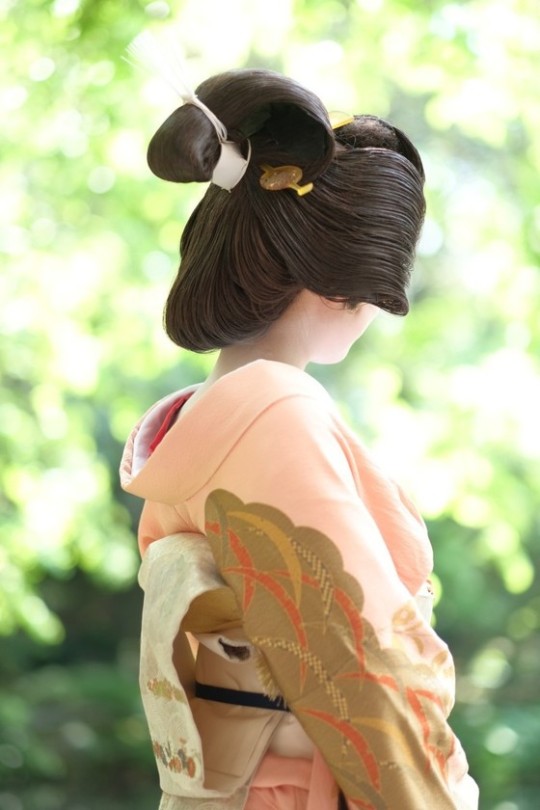
In the 1970's, Japan's period of economic growth started tapering off, interest in traditional arts dwindeled, which resulted in less work opportunities for Geigi and the number of Ryotei decreasing. In response to this, local business leaders and Shimizu Geigi started an organisation to help fostering new Geigi (Seibikai 清美会).
By 1985, their number had decreased to thirteen and the Kenban closed. In 1991, local businessmen and Geigi formed a different company (Seibi Co. 清美(株)), which worked as employer for Geigi. Due to a bad economic environment, Shimizu Odori (清水をどり) was last held in 1998, Seibi Co. was dissolved in 2004, and Haru no mai (春の舞) was discontinued in 2009. As a result of this, some of Seibi's employees became independent Geigi.
Allegedly, the number of Geigi hit rock bottom in 2011 with only two remaining. However, in 2012, around eleven Geigi worked in Shimizu. Since then, the city had a steady stream of Geigi coming and going again. At the end of this year, 2023, there are ten Geigi working in the city.
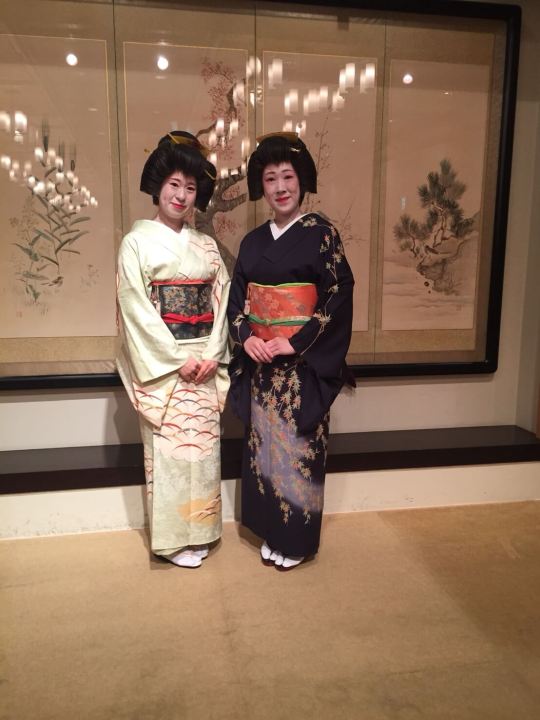
The look of Shimizu Geiko Local Term: Geigi 芸妓 ※ Hairstyle: Taka shimada, Tsubushi shimada ※ Kanzashi: Kushi, Maezashi, bekko kogai, ear of rice in the new year period ※ Kimono: Homongi, Kuromontsuki Hikizuri ※ Haneri: white ※ Obi: Taiko musubi ※ Obiage: green, pink, white, red ※ Obijime: flat, 1 knot ※ Footwear: Zori

Casual look ※ Hairstyle: Yohatsu ※ Kanzashi: none ※ Kimono: Homongi, rarely Komon ※ Haneri: white ※ Obi: Taiko musubi ※ Obiage: white, pink ※ Footwear: Zori

The look of Shimizu Maiko Local term: Shinjin Geigi 新人芸妓 ※ Hairstyle: Momoware Katsura, sometimes real hair styled (shin nihongami) ※ Kanzashi: seasonal and non-seasonal Hanakanzashi, Katsuyama, maezashi, Shidare in all age groups ��� Kimono: Furisode with shoulder tucks or no tucks at all ※ Eri: white with white embroidery, plain white, white with multicolour embroidery, other colours possible especially during summer months ※ Obi: Koken musubi ※ Obiage: flat, mostly red/silver, red/white shibori, other colours also possible (green/beige/light blue) ※ Obijime: flat or round with 1-4 knots. No obidome ※ Footwear: Zôri

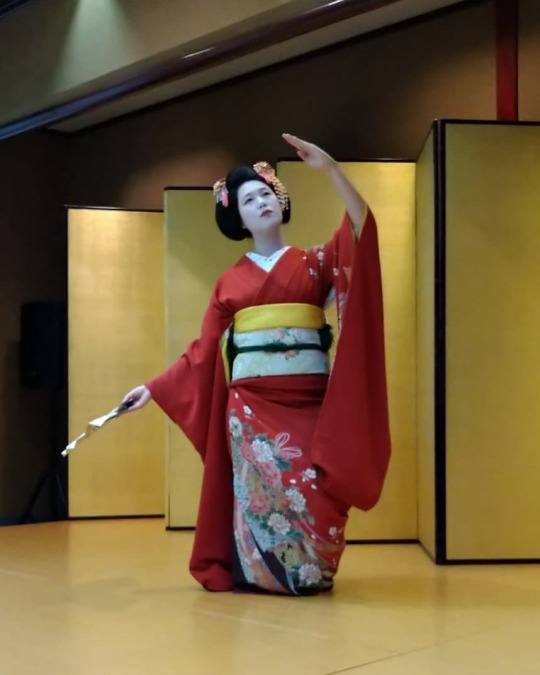
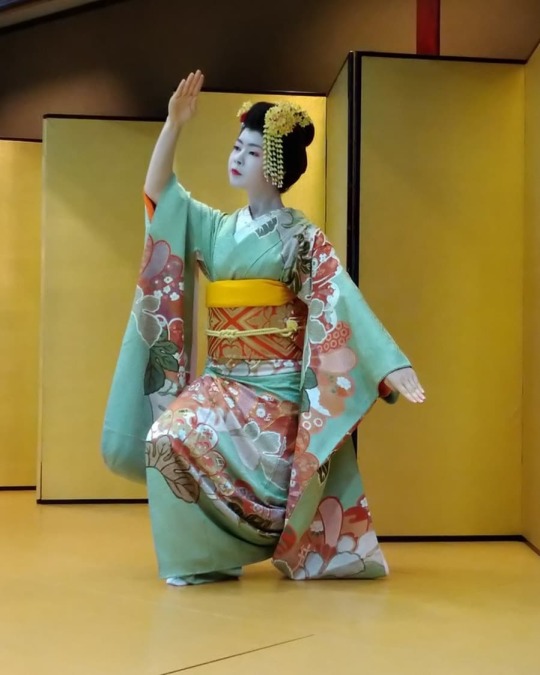
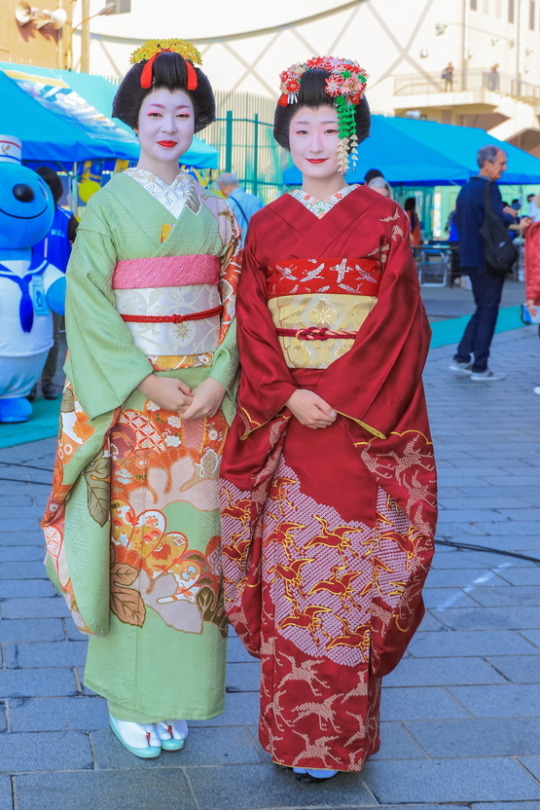
Notes Shimizu was merged with Shizuoka in 2003. Shimizu Geigi and other traditional arts performers are backed by 静岡伝統芸能振興 Shizuoka dentô geinô Shinkô-kai/Shizuoka traditional performing arts promotion association, which is the successor to Seibikai. You might notice I didn't start this post with a historical b/w photo. There are some old photos on the Shizuoka Dentogeino homepage, but they are the size of a postal stamp. And that's it. I feel let down. No chance to explore the historical style of Shimizu. Anyways. "The look of Shimizu/Shizuoka" was requested by @geimaiko. The layout of this post is based on geimaiko's own. Also... geimaiko originally started these series. If you liked this post, you should go and thank her, because without her, there would be no "the look of..." ;)
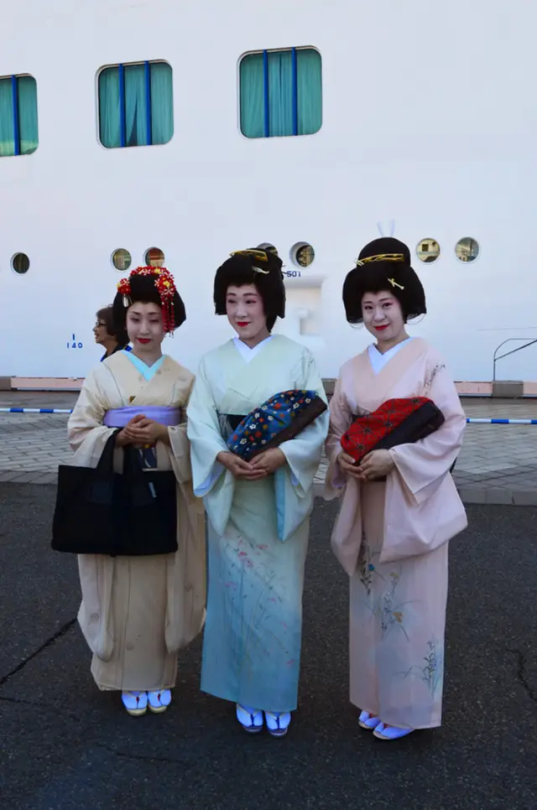

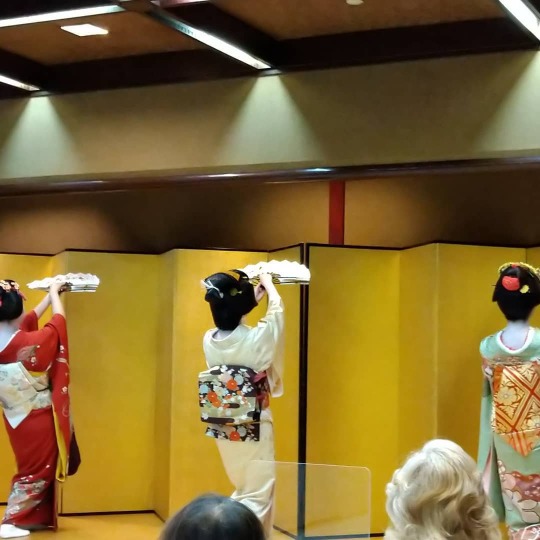
Sources https://www.shizuoka-dentogeino.jp/geigi/shizuoka_history/, https://www.shizuoka-dentogeino.jp/geigi/shimizu_history/, http://www.shimizu-port.jp/geigi.html, https://www.nikkei.com/article/DGXNZO41971500Z20C12A5L61000/ (headline and preview only), https://www.youtube.com/@shizuokadentogeino/videos
Pictures: Komachi May 17, Makoto May 17, Komachi+Makoto Oct 17 (sources nowhere to be found), Sakurako+Fukutaro Apr 22, Kikuno+Umeka Nov 14, Iroha Jun 20, Iroha Oct 20, Fukutaro Oct 20, Ichiryo+Komachi+Makoto ~2016, Komachi+Sakurako Apr 18, Fukutaro+Sakurako Oct 18, Iroha+Fukutaro+Sakurako Oct 20
#mg#geisha#geiko#maiko#hangyoku#geigi#shizuoka#kimono#komachi#makoto#sakurako#fukutaro#kikuno#umeka#iroha
117 notes
·
View notes
Text
@thecrowsart re the obi knot for 2024 Mononoke's Kusuriuri
I didn't have the right obi type for it, I used a hanhaba obi sash for the grip/strength of the fabric, so the proportions aren't perfect and I haven't nailed the length balance for the ends to stick out equally, but basically I folded some parts in half, some loop de loops, etc. This was before we got a full view of his back from the last trailer so it might need revisions. I'm gonna try making some fukuro obi mock ups for better knot testing, and marking when what fabric starts when, as fukuro obi sashes will sometimes have changes in fabric for cool effects on specific knots, which seems to be the case with this one (thus why it changes from red to purple to checkered) the little knot in the main knot is clearly an obiage, it's orange so highly unlikely to be part of the obi, plus shape is rounder so yeah. Basically this hole thing is like, knot base inspired by actually Tateya musubi knot on a fukuro obi, but the ends of the knot are the tips of the sash, whereas a tateya musubi can't do that the way it's folded.
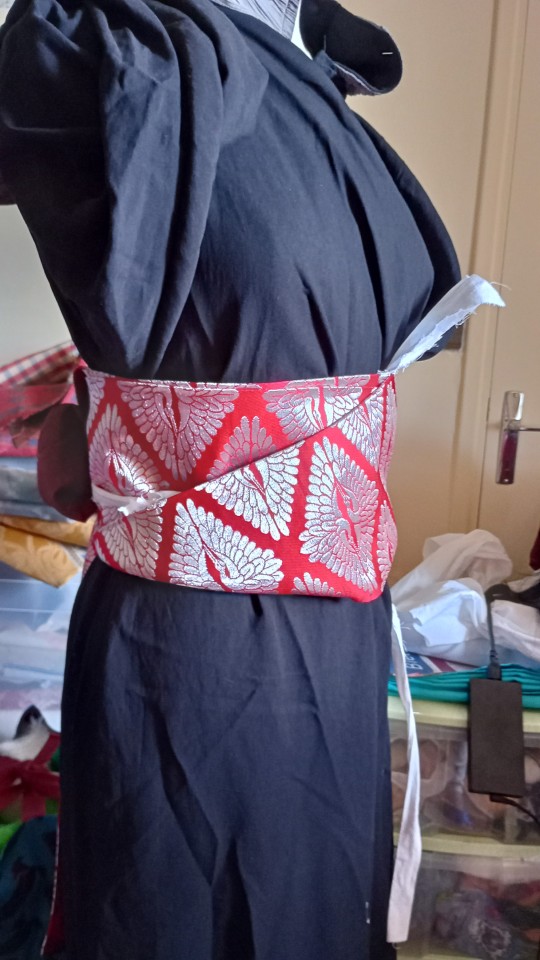


So yeah this goes a bit crazy
Someone in one of my cosplay servers suggested it might be based off Kabuki obi sashes, which had cords at the ends to tie them faster for theatre changes etc. Kusuriuri's does have a string wrapped around the obijime, so like maybe? But idk, also I'd much rather make a full one piece sash obi than have to un piece how to make a Kabuki inspired sash...
Tho tbh looks more like a cord for the round mirror, so could be wrong
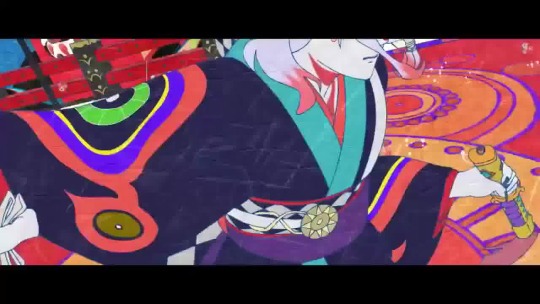
19 notes
·
View notes
Note
It's been awhile since I've seen the costumes in Star Wars designed by Asian culture since the prequels. As an Asian, I'm glad that they've brought the designs back, even if the arranged marriage scene was supposed to be depicted as uncomfortable.
yeah it's been a while! Andor did a wonderful job with it.
The arranged marriage scene speaks so much through the costumes. I love the layers that wrap around each other and eat them up with how restrictive the belts and the emphasis of formality with an obijime, like the grip "tradition" has on the charaters, and the secrets and ulterior motives they conceal.
The boy's mother probably dressed him but likely Leida dressed herself. She's the only one off-shade and has a clear bisection of the colours. It looks as if she's the only one who's actually sincere in the meeting, the one who's less 'wordly' with ulterior motives and thus less 'tainted'. Again, her belt is a free-tying one as opposed to the formal ones on the mothers.
I think it's the first time we see Mon wears a cross-collar top that's more traditional and similar to Perrin's? Both mothers share a similar style but in reverse palettes. Only Mon has Gold wrapping Blue instead of the other way round instead of the other way round. The collar-crossing is a mess but what if it signals how out of touch Mon and Leida are with 'tradition' they got even that wrong?
#Bonus points if the designers took it this far:#for Perrin to wear a woman-style obi or pair with his wife if it means anything about his daringness#andor#andor series#echoesinbox#sw costumes#my sw meta#2354#yuki watches andor#andor tv#mon mothma#leida mothma#there's so much more to talk about i wish i have time to do a costume review soon
38 notes
·
View notes
Text


It is time for weekly kimono again!
Yesterday we had a double date with a friend of mine at a cute Japanese cafe and then wandered around town before hitting up a pub for dinner. It was the first time I have worn haori in public which was fun! And cozy. Glad for it.
I dont have any pictures of my obi today because I wanted to show what the haori looks like from the back. It creates this really cozy looking, slightly rounded figure. It looks kind of like a wrapped present and makes me giggle.
My kimono is a blue water design with trees and some lotus flowers on a cream background.

A better shot of that. Also wearing my favorite obi that has obijime detailing, a pink obiage, and a HOT PINK and silver obijime. I love this obijime too and am glad to have found a way to wear it.
Enjoy my mildly spoop kimono photo!
Tags: @frywen-babbles @pseudofaux
12 notes
·
View notes
Photo

Beautiful all black outfit (seen on). I really like how OP paired that speckled kimono with this beautiful Hakata obi and round fabric obijime (maruguke).
All black is usually reserved for mofuku (mourning attires where only undergarments are white) in kimono fashion, it’s nice to see that style brought into street fashion!
0 notes
Text
The look of... VI: Morioka
Welcome to the 17th installment of this series (my 6th). This time, we’re having a look at the Geigi that work in Morioka.
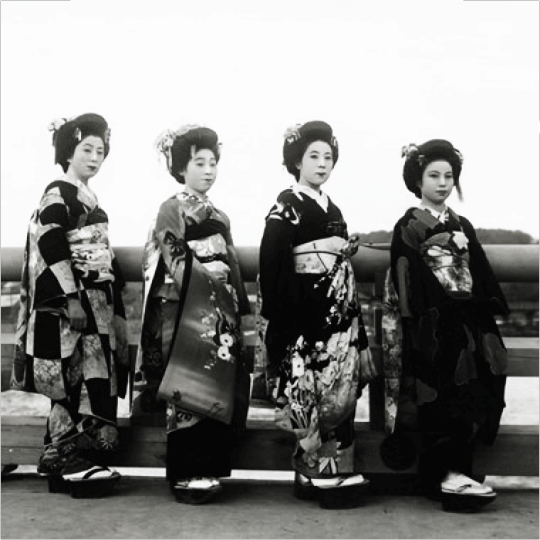
Historical context It's not known when Geigi in Morioka started to exist, but they trained with Tokiwazu Rinchu 常磐津林中 who lived in Morioka from 1892-93. At this time, Morioka had two Hanamachi: Hatamachi 幡街 and Honmachi 本街. Hatamachi was frequented by customers of the merchant class, whereas Honmachi was the government office district, so the Ryotei there were mostly frequented by government workers and politicians. From 1898 onwards, they were training dance with Wakayagi Rikiyo I 初代若柳力代, originally a Kabuki actor who turned to teaching in his later carreer. In 1911, 54 Geigi worked in Hatamachi and 41 in Honmachi. 30 Ryotei operated in the entire city. In 1913, the Morioka theatre was opened and the Joruri piece "Hanabutai chiyo kaomise" 花舞台千代顔見 was composed by Matsumoto Koshiro VII 七代目松本幸四郎, who invited the Morioka Geigi along him. The lyrics were passed down orally along with the choreography. This joruri piece is performed by the Geigi up to this day. Coming to the present day, the segregation of "Hatamachi" and "Honmachi" no longer exists. They are all "Morioka Geigi", no matter where in the city they live. The Kenban no longer exists and there are no Okiya, all Geigi are independent. After a span of 19 years with no fresh blood, two young Geigi debuted in Morioka in 2012, followed by two Hyoko (Maiko) in 2016.

The look of Morioka Maiko Local Term: Hyoko ひよ妓 - used to be called Hangyoku 半玉 ※ Hairstyle: Momoware Katsura ※ Kanzashi: Manjugiku 萬寿菊 all year (2 sets: white/pink/green, white/red/green). Katsuyama and Daikan. First year with Shidare. Rice husk in the new year period. 1 Birabira, 1 Hirauchi, red Kanoko ※ Makeup: Oshiroi, both lips painted ※ Haneri: red with white embroidery, seldomly white ※ Kimono: Furisode without tucks ※ Obiage: flat, tied in the back. red/silver, red/white shibori, July-September: single colour pink and light yellow, white ※ Obi: Koken musubi ※ Obijime: round, flat, single knot ※ Footwear: Zori
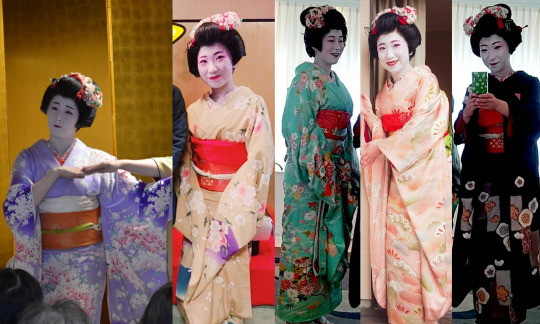
The look of Morioka Geiko Local Term: Geigi 芸妓 ※ Hairstyle: Geiko shimada ※ Kanzashi: Kushi, Maezashi, rice husk in the new year period ※ Makeup: Oshiroi, both lips painted ※ Kimono: Homongi, Kurotomesode ※ Haneri: white ※ Obi: Taiko musubi ※ Obiage: red, pink, white with red Shibori (with Kurotomesode always white/red), white ※ Footwear: Zori
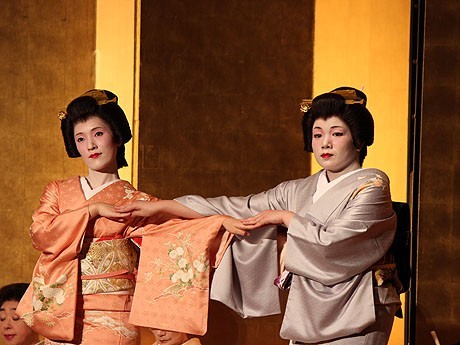

Casual look Young and old Geigi alike often opt for a simpler look, both when dancing and when playing Shamisen… ※ Hairstyle: Yohatsu ※ Kanzashi: none ※ Makeup: no Oshiroi ※ Kimono: Homongi, Kurotomesode ※ Eri: white ※ Obi: Taiko musubi ※ Obiage: white ※ Footwear: Zori
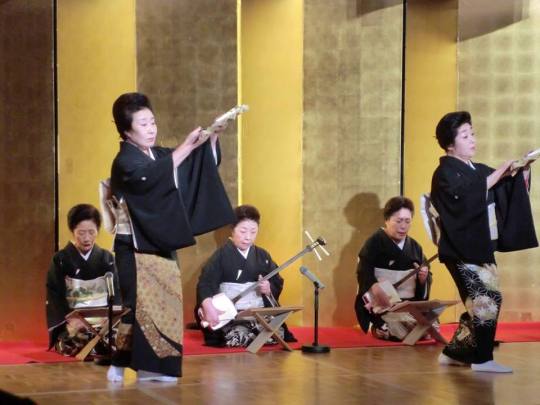

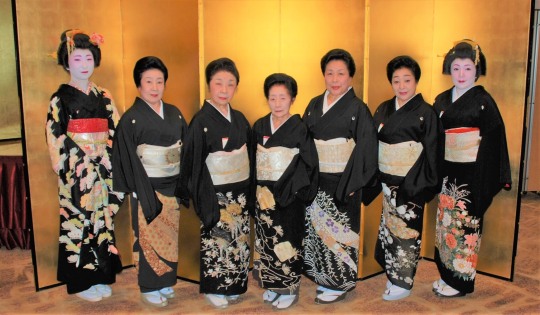
Dances In comparison to other small Hanamachi, more than just two or three dances of their repertoire have been documented: ※ Aki no yo 秋の夜 ※ Enkaina 縁かいな ※ Furyufunazoroi 風流船揃 ※ Hanabutai Chiyo Kaomise 花舞台千代顔見 ※ Haru kasumi 春霞 ※ Harukoma 春駒 ※ Kimigayo Shochikubai 君が代松竹梅 ※ Kishi no Yanagi 岸の柳 ※ Kanayama odori karame bushi 金山踊からめ節 ※ Mori no nagame 杜の眺め ※ Nanbu ondo 南部音頭 ※ Natsu to kabocha 茄子とかぼちゃ ※ Sekizoro せきぞろ ※ Yama wa iro nasu 山は色なす ※ Yûgure 夕暮れ Check out the video linked below, the channel has more videos of this kind.

Notes ※ The joruri piece "Hanabutai Chiyo kaomise" received updated lyrics in 2013, reflecting the passage of 100 years after its creation. It's now called "Hanabutai Chiyo kaomise - Heisei version" 平成版 花舞台千代顔見. ※ The local term for the registry office was chosen to be "函番". Mostly pronounced Kenban like the Geigi registry offices all over Japan, but also "Kanban". The "函" character was also used for the Shamisen case - Geigi's Shamisen were stored in the Kenban and from there, brought to the Ryotei if needed. ※ Geigi Yôko よろ子 is Wakayagi Rikiyo IV. ※ Apprentice Geigi start dance training first, beginner dances being Kanayama Odori and Nanbu Ondo. Second the start training Shamisen and third Nagauta. ※ The b/w photo of the hangyoku is literally the only photo of Morioka Gei-/Maiko from before 2012 I was able to find. You can see the girls are wearing their own hair, Hikizuri and Darari Obi. The style has changed drastically! ※ This particular feature on Morioka was requested by @geimaiko. Thanks for the impulse! ※ If anyone reads this far... I’m happy to explore more Hanamachi. If you have a request, feel free to drop it in my inbox. An overview of what has received in-depth research before, you can find here. Sources ※ text: past Hanamachi, 1911 numbers, beginner training, school of dance Wakayagi-ryu, kenban/okiya system defunct, 1993 debut (only mentioned, no picture of it, sadly!), everything else ※ dances: hanabutai, harukoma, nanbu+karame+haru kasumi (video), aki+natsu, kishi, yama+enkaina+sekirozo, furyu, mori+yugure, kimigayo (followers-only account) ※ pictures: collage 1: beige flower furisode, Kikumaru/Marika debut, dark blue furisode, collage 2: all from Kikumaru’s instagram, Tomochiyo/Tomiyu debut, Kikumaru erikae, jikata in sepia tones, new year’s photo (Facebook), veteran geigi dancing (Facebook), 3 geigi dancing. Hangyoku. [Facebook has been restricting browsing for people who are not logged in recently, so I can’t look up the exact sources. Kikumaru’s instagram is private] ※ Original layout: @geimaiko ♥
77 notes
·
View notes
Photo




Delicate and fresh outfit, featuring a dynamic ryuusui (running water) kimono in blue tones, paired with an elegant botanical obi depicting botan (peony) and ume (plum blossom). The maruguke (fabric round obijime) nicely anchors the outfit.
The dye styles gives a lovely earthenware feeling don’t you think?
#japan#fashion#kimono#obi#ryuusui#stream#running water#botan#peony#ume#plum blossom#maruguke#round obijime#fabric obijime#着物#帯
267 notes
·
View notes
Photo

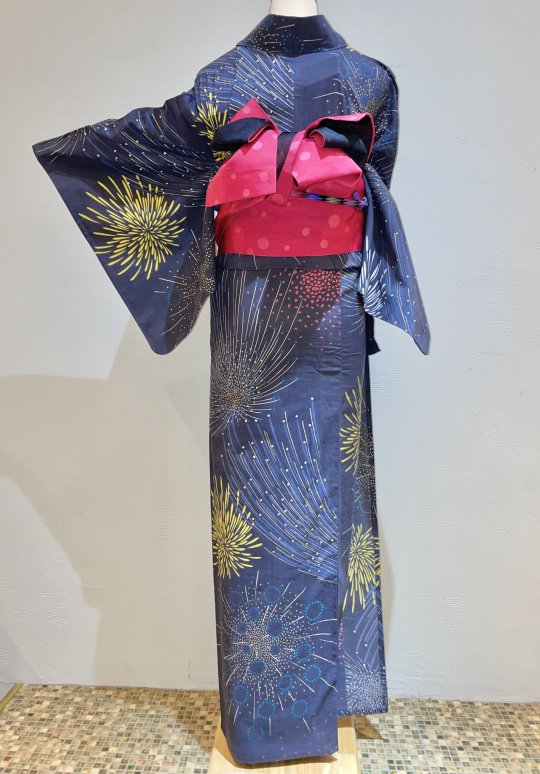
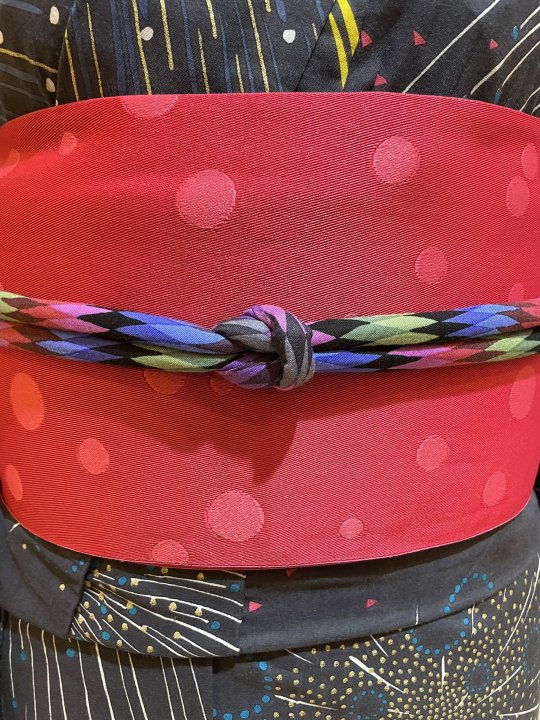

Fun hanabi (fireworks) yukata, styled with a colorful marukuge (round fabric objime).
Marukuge are obijime made from fabric tubes filled with cotton. In the past they were mostly used for formal attires (like mofuku/mourning dress, tomesode/formal kimono, or shiromuku/bride white kimono). Recently, they’ve been used more and more with furisode, then some fashionista made the jump and started using them for informal kimono too.
Wearing them with yukata is a bit weird to my eyes (as they look pretty “heavy” = not airy summer weave), but I like the dash of fun this one adds to the outfit!
#japan#fashion#kimono#obi#yukata#summer in japan#hanabi#fireworks#marukuge#round obijime#fabric obijime#着物#帯
135 notes
·
View notes
Photo

Beautiful all black outfit (seen on). I really like how OP paired that speckled kimono with this beautiful Hakata obi and round fabric obijime (maruguke).
All black is usually reserved for mofuku (mourning attires where only undergarments are white) in kimono fashion, it’s nice to see that style brought into street fashion!

(picture from)
545 notes
·
View notes
Photo
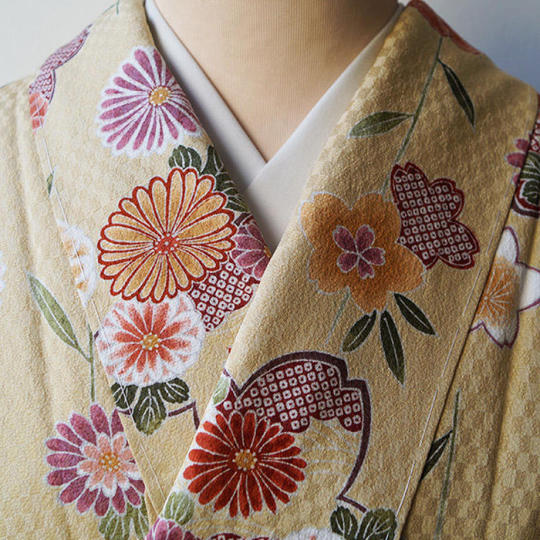
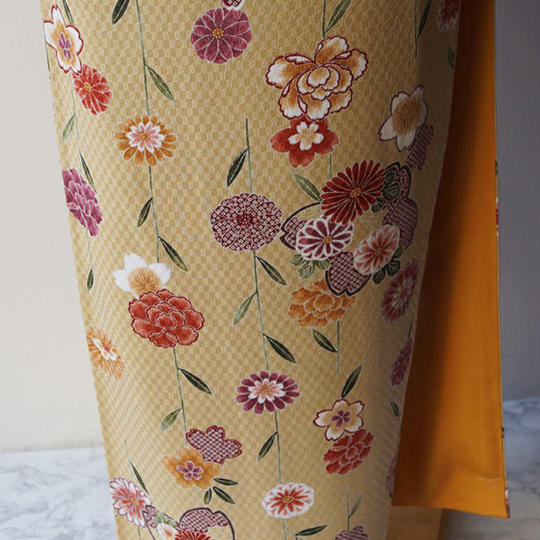
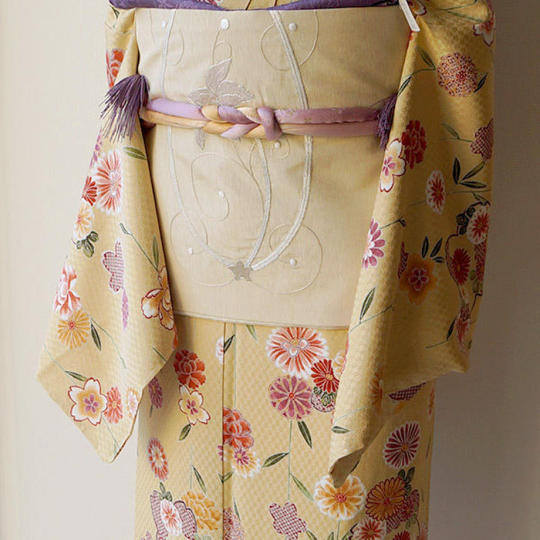
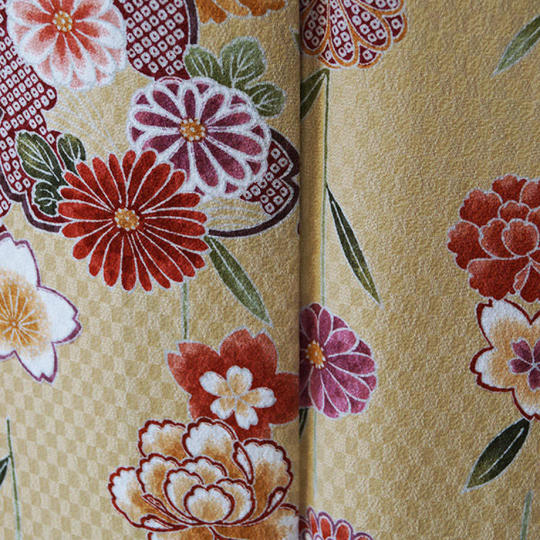

Homey outfit in sunny colors, featuring a checkered mustard kimono with kiku (chrysanthemum) and sakura (cherry blossom) pattern, paired with quiet obi closed with a lovely ombre marukuge (round fabric objime).
Marukuge are obijime made from fabric tubes filled with cotton. In the past they were mostly used for formal attires (like mofuku/mourning dress, tomesode/formal kimono, or shiromuku/bride white kimono). Recently, they’ve been used more and more with furisode, then some fashionista made the jump and started using them for informal kimono too.
I love how here the obijime plumpness just add to the overall comfy mood :)
#japan#fashion#kimono#obi#ichimatsu#checkered#kiku#chrysanthemum#sakura#cherry blossom)#objime#marukuge#round fabric objime#着物#帯
238 notes
·
View notes
Text
The look of... IV: Hakata/Fukuoka
Historical context
It is said that the first Geigi started working in Hakata in the middle of the Edo period (1750s). Osaka Geiko were invited to entertain in Nagasaki, but they were limited to staying 100 or less days in the city, so they temporarily worked in Hakata, before returning to Nagasaki again. Some of those settled permanently in Hakata, making them the first Hakata Geigi.
The first official date in the history of the Hakata hanamachi is 1889, when Hakata was merged into Fukuoka and Aioi Kenban 相生券番 was established. For those of you who don't know, a Kenban is an agency for Geigi, similar to an agency for other artists.
In 1897, Nakasu 中洲 Kenban and in 1901, Mizuchaya 水茶屋 Kenban were established. In the Taishô era (1912-1926), two more Kenban were established: Shin ��� ("new") Kenban and Minami 南 ("southern city") Kenban. In the Meiji and Taishô era, the Hakata hanamachi was flourishing and the number of Geigi exceeded 2000. In the early Shôwa period (1937-45), the maximum number of Geigi was 884. During the second world war, the Kenban system was completely dissolved. After the war was over, only Nakasu and Mizuchaya Kenban picked up business again. Like all over the country, the interest in traditional culture dwindeled and the number of Geigi shrunk. In 1985, Nakasu and Mizuchaya Kenban were merged to form Hakata 博多 Kenban. Currently (April 2022), there are four Jikata Geigi, nine Tachikata Geigi and two Hangyoku in the city. The look of Fukuoka Maiko Local term: Hangyoku ※ Hairstyle: Momoware Katsura ※ Kanzashi: Kushi, seasonal Maezashi and Daikan ※ Makeup: Oshiroi, both lips painted from the start ※ Kimono: Furisode with shoulder and sleeve tucks ※ Eri: red with white embroidery ※ Obi: Han-Darari, Kôken musubi in summer ※ Obiage: flat, shibori (white, pink, red/white)/otherwise red with silver embroidery ※ Obijime: flat or round with 1 knot, no pocchiri ※ Footwear: Zôri

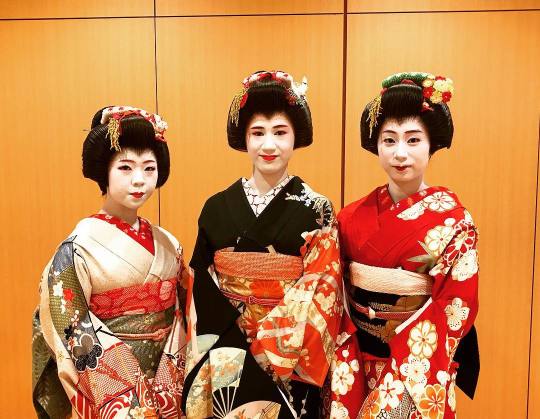
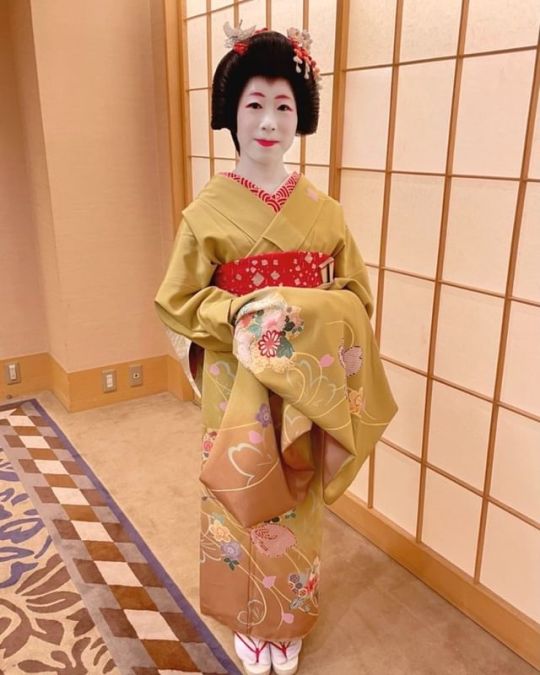
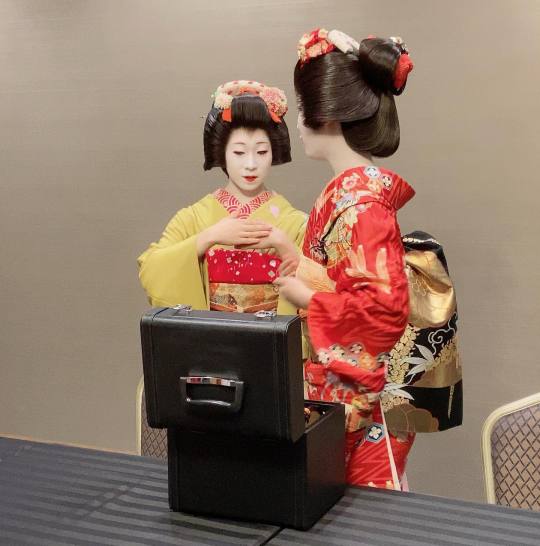
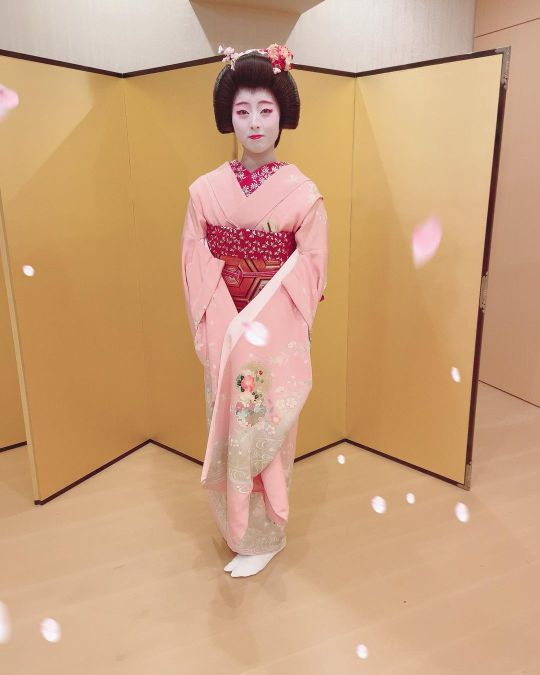
The look of Fukuoka Geiko Local term: Geigi ※ Hairstyle: Geiko shimada Katsura ※ Kanzashi: Kushi, Bekko kogai in front and back, Maezashi ※ Makeup: Oshiroi ※ Kimono: Kuromontsuki Hikizuri, otherwise Hômongi ※ Eri: white ※ Obi: Yanagi musubi with Hikizuri, otherwise Taiko musubi ※ Obiage: always red with Kuromontsuki, otherwise white or light blue ※ Footwear: Zôri, Geta with white or blue Hanao
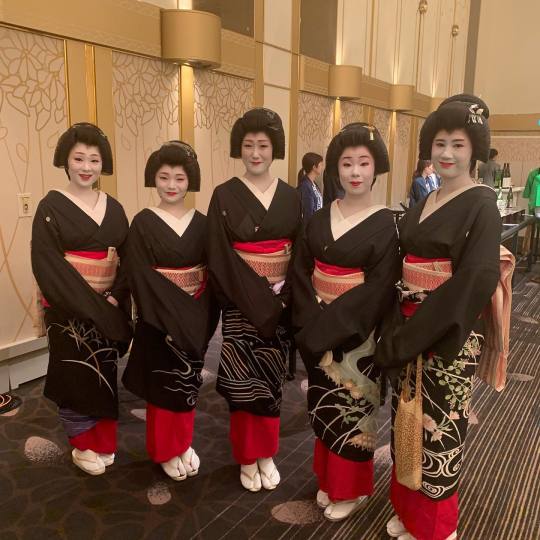
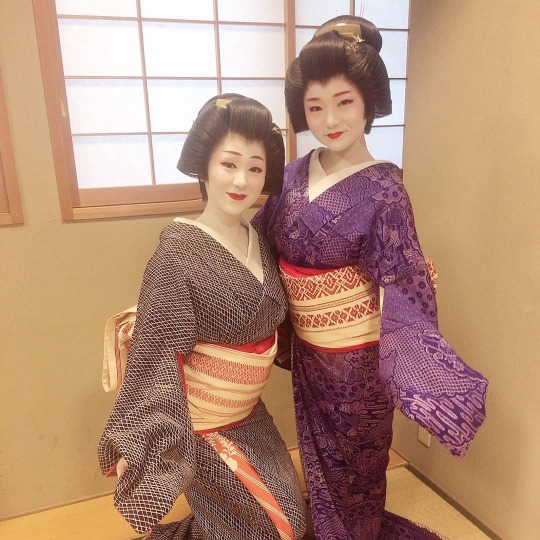

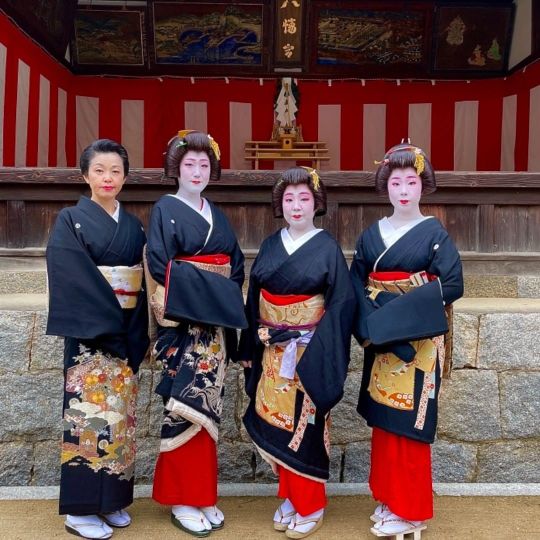

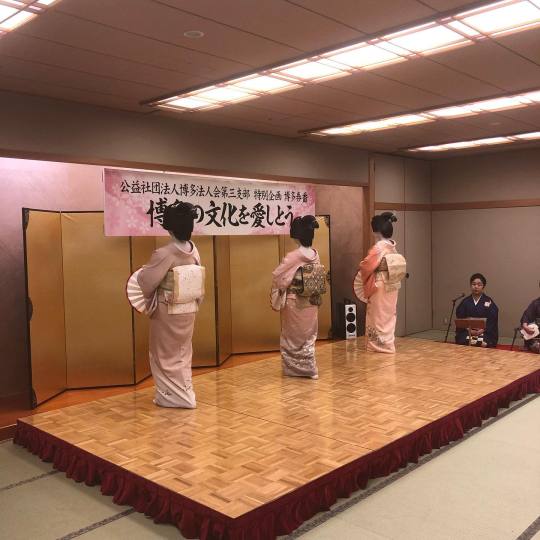
Notes In some cities, Geigi are sorted by which Kenban they are registered at rather than in which Hanamachi they work. Apart from Fukuoka, you can see this system in Matsuyama. Hangyoku have been seen performing while wearing Iromuji or Hikizuri (the latter with Darari obi) too. Elderly Tachikata Geigi often wear the same, more simple, outfit like Jikata Geigi. Some Tachikata wear male attire, their wig is in Maeware style, their Obi in Kôken musubi, and their Kimono is without trail and usually more subdued colours.

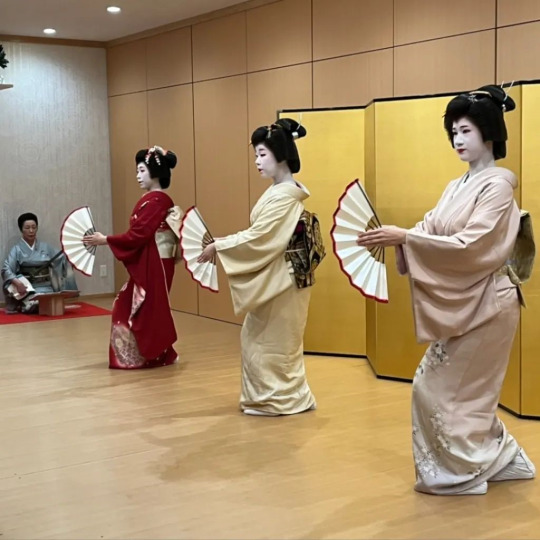
Sources Layout by @geimaiko ♥ https://hakata-geinou.jp/img/request_en.pdf http://hakatakenban.com/history/ https://en.wikipedia.org/wiki/Fukuoka#Formation_of_the_modern_city_(1889) https://www.youtube.com/watch?v=S8PjkayL6eo (3:43) Pictures: Hangyoku dancing 2018, Nono, Reika and Kotone 2019, Nono and Kotone 2019, Hinazuru debut 2021, Hinazuru and Kochô 2021, Kochô debut 2022, Kuromontsuki with Hakata weave obi 2019, Shibori Hikizuri 2019, Wanoka debut 2020, New year 2021, Senior Geigi dancing (Umeka?) 2021, Obi showcase 2022, Koharu, Kochô and Hinazuru 2021, Hinazuru, Kochô and Reika dancing 2022
Original post from April 2022, last updated August 2024
#MG#fukuoka#kimono#geigi#geiko#geisha#maiko#hangyoku#nono#Kotone#Reika#Hinazuru#Kocho#koharu#2018#2019#2020#2022#2021
60 notes
·
View notes
Text
The look of... III: Osaka-Nanchi
Historical context "Nanchi" (南地), referring to southern Osaka, was originally an umbrella term for five Hanamachi, called Kuroemon-cho (久郎右衛門町), Soemon-chô (宗右衛門町), Namba-shinchi (難波新地), Saka-cho (坂町) and Yagura-cho (櫓町). It is said that in 1935, around 2000 Geiko and Maiko called Nanchi their home, making it the biggest Hanamachi in Japan. Geiko numbers declined heavily in the meantime. Other big cities like Kyoto and Tokyo could maintain a fairly high number of traditional entertainers (currently ca 260 Geiko and Maiko in Kyoto and ca 200 Geisha and Hangyoku in Tokyo, plus a hand full of Taikomochi), whereas Osaka's Hanamachi population is currently around 10 Geiko and no Maiko. From at least 2014 to 2018, there was only one Geiko working in Nanchi, a veteran of the profession named Kikutsuru (菊つる). It's likely she has retired meanwhile, as no mentioning of her was found after the official introduction of Tanigawa's (たに川) fresh blood in May 2019.
Tanigawa was founded in 1969 and is Nanchi's only remaining Ochaya/Okiya. After a long drought period with no apprentice actually making it to debuting as a Geiko, five Geiko have debuted from this business since 2019 and one more should debut later this year or maybe in 2022, depending on how the general situation in Japan develops.
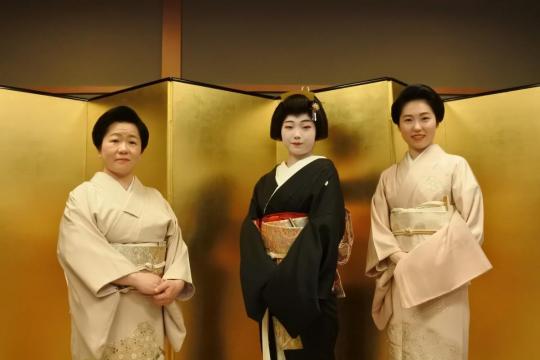
The look of Nanchi Geiko
Tachikata ※ Hairstyle: Geiko Shimada Katsura ※ Kanzashi: Kushi, Maezashi, Hirauchi in the back. Nemaki cut ca 1 year after debut. At occasions which require the wear of Kuromontsuki, additional Bekkô Kogai is worn in the back. New year's celebrations see the addition of a rice husk in front and the Hirauchi may be swapped for prong kanzashi with coral Tama. ※ Make-up: both lips painted, Oshiroi ※ Eri: white ※ Kimono: Hikizuri. Kuromontsuki have white lining. Komon pattern seems to be very popular. ※ Obiage: red, during the summer months pink (also applies to Juban colour) ※ Obi: Taiko Musubi ※ Obijime: flat, single knot ※ Footwear: mostly Geta, Zori are worn with Montsuki Kimono

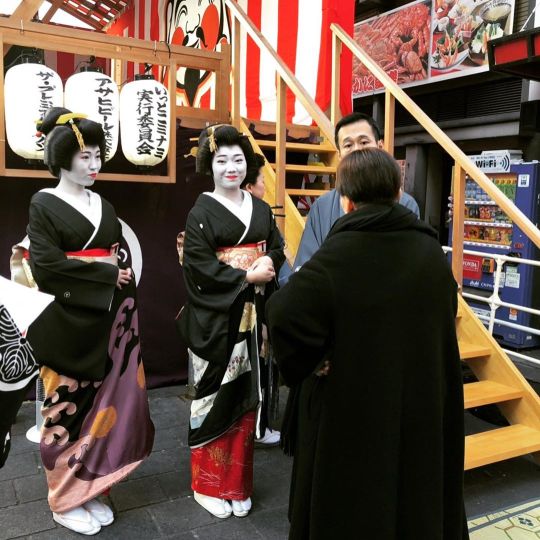


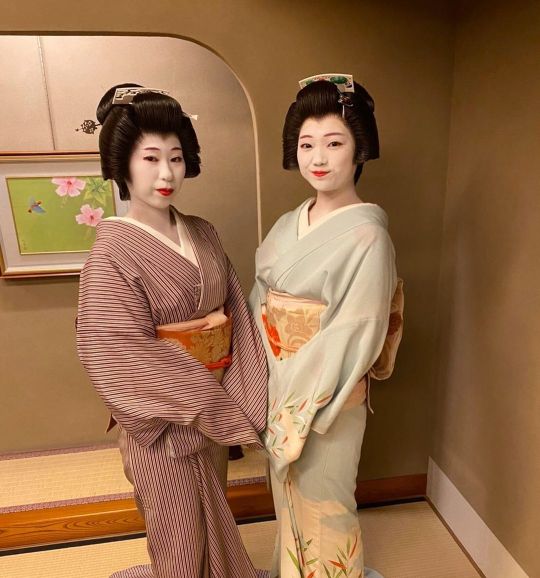


Jikata/Minarai/"casual" outfit ※ Hairstyle: Yôhatsu or simply combed back with a bun ※ Eri: white ※ Kimono: mostly Hômongi, but also Komon and Iromuji ※ Obiage: warm pastel colours, mostly pink and beige ※ Obi: Taiko Musubi ※ Obijime: flat or round, single knot ※ Footwear: Zori
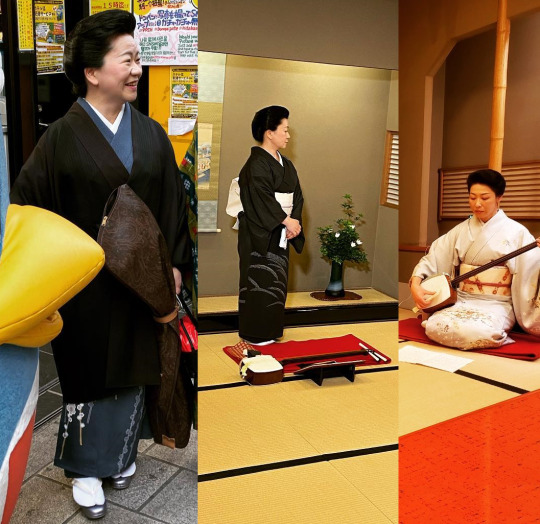

Notes: ※ Tachikata have the opportunity to wear the "casual" outfit instead of Katsura+Hikizuri (Tamizuru did so five to six months after her debut) ※ the two Jikata who debuted since 2019 didn't appear in promotional photos after their debut, but sometimes, you can get a glimpse of them ※ Minarai wear the "casual" outfit until a few months before their debut. Their professional names are revealed around 1 month after becoming minarai. ※ every year on 14. June, the Ochaya owner and Geiko (and others who are unrelated to the Hanamachi) appear in public wearing dark-coloured Iromuji (purple, dark blue), visiting Sumiyoshi-Taisha shrine, where a ritual called Otaue shinji (御田植神事) takes place. It has been designated as an "important intangible Folk cultural Asset" by the national government as one of the most representative rituals in Japan. ※ before the debut of Yaezuru, Tamizuru and Tamako, Geiko from Nara and Kitashinchi were frequent guests at Tanigawa ※ Miyagawacho Geiko Tae (多栄) was originally working as a Geiko named Fukuemi (福笑) in Nanchi, before retiring in 1993. She continued to teach Nagauta in Osaka until she debuted as a Geiko again in 2017 ※ once again, thanks a lot to @geimaiko for inspiration and allowing me to use her layout. Go and check out her blog if you're interested in the Hanamachi! Lots of interesting stuff to read!
Sources: Sumiyoshi 1║Sumiyoshi 2║Otaue Shinji║║Fukuemi║Nara Geiko with junior Owner of Tanigawa║1935 population numbers ║kanzashi terms
Picture sources: debut 2019║Tamako back║new year (couldn't find the original source. If you know, pls contact me and I'll add it)║Ichizuru+Tamako║summer 1║summer 2║Katsura back view║striped Hikizuri║Yaezuru 1║Yaezuru 2║Orizuru║Ichizuru+ Tamako 1║I&T 2║I&T 3 ║I&T 4
#MG#Osaka#Nanchi#geiko#geigi#geisha#maiko#hangyoku#2020#2021#Tamako#Tamizuru#Ichizuru#Yaezuru#Orizuru
68 notes
·
View notes
Note
how would the Geisha/Geigi Of Tokyo and Kanazawa Debut? Is it somehow like Kyoto or different?
Unfortunately, I know only very little about the debuting process in Kanazawa or Tokyo. Freshly debuted Kanazawa Geigi are called "Shinbana", and receive their Geimei on the day of their debut by the Mayor of Kanazawa. Debuts in Tokyo often go unnoticed, there is no big crowd like in Kyoto. Shinbashi Geisha wear bekkô kanzashi (Kushi, Maezashi, Kogai) and a light-coloured outfit (pastel Hômongi, white-red Obiage, white Obijime, Taiko Musubi Obi). The look is very similar for Akasaka Geisha (a bit more colourful - but tbh, I only have pictures of Kikumaru's debut as reference). Hachioji Geisha wear a more formal outfit (Kuromontsuki Hikizuri, red Obiage, with a golden Yanagi Musubi Obi). In Asakusa, I never saw pictures of Tachikata debuts. However, Jikata wear an everyday outfit, which is in the same vein as what they wear later in their carreer. As for the other districts, I have no pictures. New Geisha debut frequently in Mukojima, but I assume they don't wear a special outfit. So, their looks are different, but I assume new Geisha/Geigi make their rounds to introduce themselves to the Okiya/Ryotei/other businesses they will deal with in their district, just like in Kyoto.
6 notes
·
View notes
Note
How do you tell the difference between a furisode san and hangyoku in tokyo just by appearance?
Hey anon! I already wrote about that topic last year, so please read this post: https://maigeiko.tumblr.com/post/186091935244/
However! When I wrote the answer to the ask last year, I wasn’t aware that the company hosting the Asakusa Furisode-san had changed in 2017, and so has their style. They will wear much more red/silver Obiage (like Hangyoku) or red/white Eri (like Hangyoku), red Hair ties and Kanoko (like Hangyoku). But sometimes, Hangyoku wear pink hair ties and Kanoko (like Furisode-san). And you have to be aware that Tokyo doesn’t have a general style of Hangyoku, they all differ a bit when you compare the styles of the various Hanamachi.
If you have a back picture, the red ball (tama) kanzashi is an easy hint: the Furisode-san has a stick made of a material which resembles tortoise shell (bekko), whereas the Hangyoku has a metal stick (for the lack of a better word...). In the example, you can see the head of Furisode-san Suzume on the left, and the head of Hangyoku Teruha on the right. You may be aware of the fact that Teruha is from Hachioji. I couldn’t find a proper back picture of an Asakusa Hangyoku, but a couple of side pictures suggest that they either wear a metal stick like in Hachioji or something with a round, flat centerpiece (back of a Mukojima Hangyoku for comparison).

Then, we have a look at the Obiage. I have observed that the Obiage of Furisode-san has a bit more volume and is tied differently. Hangyoku’s Obiage is much flatter.
The third feature to look at is the Obijime. One knot: Furisode-san. Three or more knots: Hangyoku.

While writing all this stuff, I was scrolling a bit through the instagram of “Hana Furisode” and different Furisode-san and it turned out that sometimes they have three Obijime knots indeed. There is no general rule to keep them apart, you have to look at the overall picture. Keep in mind that there are only few Hangyoku in Asakusa (1 at the moment), but a lot of Furisode-san (9 at the moment). I just keep track of which Hangyoku are/were active in Asakusa and when in doubt, I take a closer look at their faces to see who is who.
47 notes
·
View notes
Note
In regards to you post about hair styles in the hanamachi. You stated that hangyoku do in fact were pink. How do I tell the difference between and furisode-san and hangyoku in a wig?
The problem with telling the difference is that they look so similar and I don’t have a lot pictures of Asakusa Hangyoku. In some cases, you can’t distinguish them unless you recognize the faces. But I have noticed some little things that are unique to the look of the Furisode-san…1. The style of their Furisode. Look at this Furisode. It’s beautiful but the overall design looks quite contempoary even for me, and I’m not good at distinguishing “modern” and “traditional” Kimono design. 2. The Obijime. If it has only one knot, then the lady is not a Hangyoku. Hangyoku’s Obijime always have a triple knot when they don’t wear a Pocchiri.3: The Obiage shape and colour. This one has a clear bulge and it is plain white. The Obiage worn by Hangyoku are mostly red/silver, sometimes pink or white with red shibori and a bit wrinkly. Green and blue Obiage are pretty… and a sign that what you’re looking at is certainly not a Hangyoku.4. The Pocchiri. Furisode-san will wear a small Pocchiri on rare occasions, hardly visible. Asakusa Hangyoku also hardly wear Pocchiri, but when they do, the Pocchiri is clearly larger. Not as large and fancy you are used to from Kyoto Maiko, but the difference is obvious when you see it.5. Footwear. Both Furisode-san and Hangyoku wear Zôri like 90% of their time. But once you see somebody wearing Okobo, she’s definitely not a Furisode-san. (no picture)6. Hair decoration. The top of the Momoware mage is usually decorated with a Kanokodome, but I have yet to see a Furisode-san with a Kanokodome. Also, look at the round Maezashi in picture 1. it’s also a easily recognisable piece of the Asakusa Furisode company.





Photo srcs: Furisode, Obijime, Obiage, Pocchiri, Wig.
25 notes
·
View notes